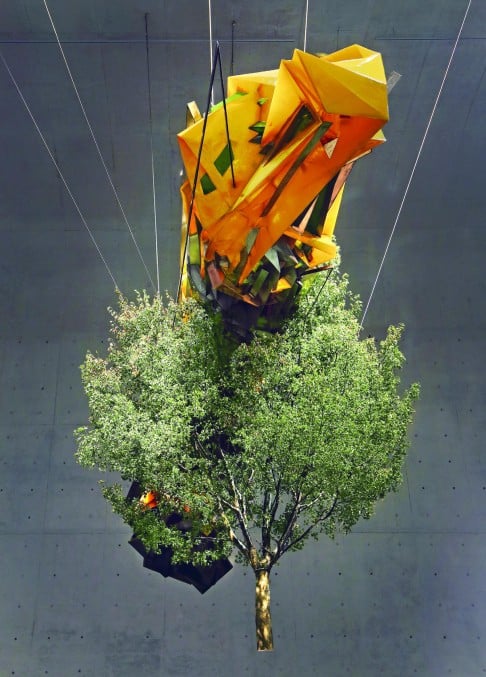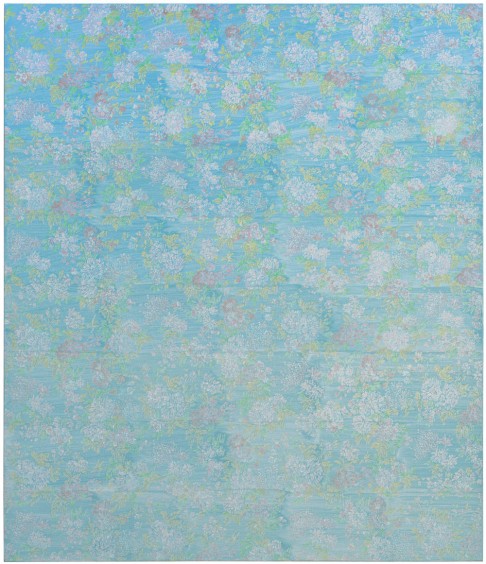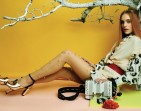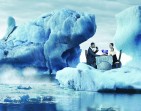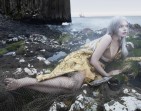http://multimedia.scmp.com/nomads/
Not only is it bad luck, it’s also considered extremely rude.
When our guide, Australian adventurer, filmmaker and author Tim Cope, tells us this, I presume it’s a romantic reference to nomadic life being all about “the journey”. A few car breakdowns later, I discover it’s to be taken literally: in this vast, unpredictable country, it’s pointless trying to predict how long it’ll take you to get anywhere.
Click the map icons to follow the trekkers on their journey.
We’re also told we’ll no longer need our watches (or
smartphones – there’s no network). Cope and his right-hand man,
Tsenkhee, an urban Mongolian who communicates with his boss in fluent
Russian, will see to it that we get plenty to eat and enough sleep.
Rushing is sacrilege here, and it will not be until I return to Hong
Kong that I’ll realise how tightly measured my time usually is; divided
into tiny allotted portions from breakfast to bedtime.
While just under a third of Mongolians are nomadic or semi-nomadic, the four herders travelling with us are different in that they’re living much the same life as they would have thousands of years ago. They still travel by camel and use no generators or water pumps. They’re not tour guides, as such; they’ve been hired specifically to accompany us and apply their skills to our needs.
It takes time for eyes that are unfamiliar with the sprawling sandy plains and endless blue sky to adjust to the scale of the environment. There is no private land ownership, here, no farms, fields or fences. There’s no tourism infrastructure where we’re heading, either: no stores, no fridges, just what we (and our camels) can carry.
The herders laugh when I tell them they live like kings compared with us. But you do the maths: Mongolia’s 1.5 million square kilometres are shared by just 3 million people, making it the most sparsely populated country in the world. Hong Kong, at just 1,104 sq km, is home to 7.24 million.
We walk from breakfast through to dinner, the camel train following with our tents and duffel bags. One beast groans loudly each time its load is packed and unpacked, protesting like a grumpy old man, his mouth full of food. These creatures are surprisingly agile and strong, however, and when nomadic communities migrate from one pasture to another, a single animal will carry up to 300kg: all a family’s wordly belongings and their ger, their round tent-like homes commonly referred to by the Turkic word yurt.
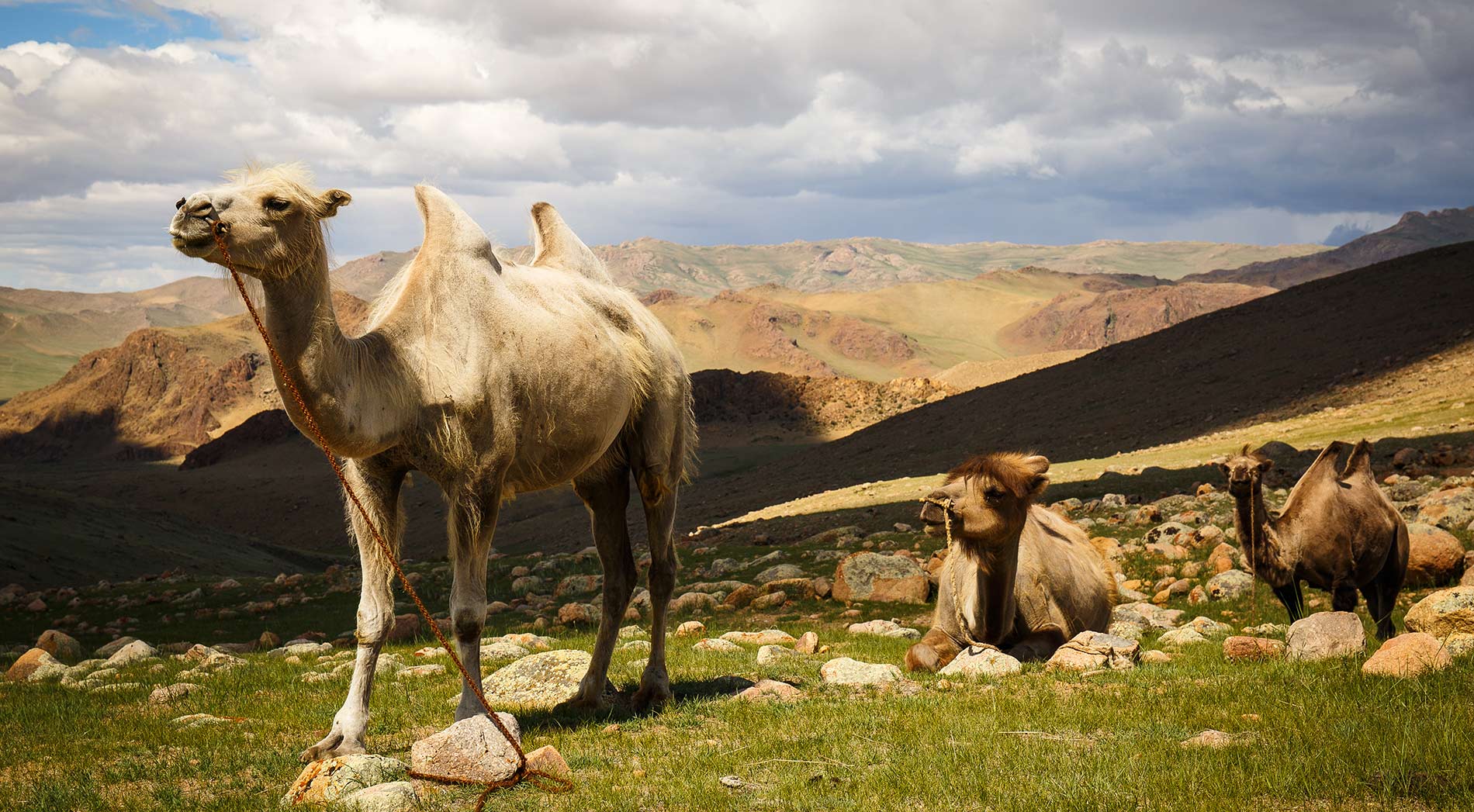
During a nomad family migration, camels
can carry loads of up to 300kg. These camels dutifully wait to be loaded
up with trekking gear as support for the tour.
Cope has a secondary career as a postman; on each tour he
leads, he brings photographs from previous trips and delivers them to
people on the steppe, often a year after the pictures were taken.
Families gather around him in delight, sifting through his photos, and
pose for us as we take snaps that will be delivered next time.
By the time we reach our first camp – the herdsmen having raced ahead on the camels to set up the tents – our legs are buckling.
We’re invited into a ger that has been set up for the season nearby, and offered salted yaks’ milk tea, curd and boortsog (fried dough sticks). The tent’s residents are the first of many Khovd families we’ll pay informal visits to. At each ger, we’ll be given a traditional nomad welcome: copious amounts of food, tea and home-brewed vodka.
Twelve years ago, such hospitality provided Cope with a lifeline during a three-and-a-half-year horseback ride from Mongolia to Hungary, a journey he later recounted in a film series and book, titled On the Trail of Genghis Khan.

“I remember being invited in, in all states of disrepair,
sometimes in the winter, when it was minus 40 or 50 degrees Celsius,
sometimes in the summer, when it was 40 or 50 degrees. They’d take me in
like a long lost son,” says Cope. “The people here offer us a very
different approach to life. They’re very trusting – they’ll give you
their own shirt off their back. Hospitality really is the lynchpin of
survival here.”
One night, sitting in front of the icy Shivreen River, we introduce ourselves properly to the herdsmen and our two beautiful young Mongolian cooks, Otga and Nana. They listen intently while we ramble on about our jobs, families and pets, Tsenkhee translating. I ask them what they like most about being a nomad.
“All,” says one. “The animals,” says another. What do they like least? “Nothing.”
Over the days that follow, we trace the migratory path of nomadic families as they move to their summer camps, seeking out higher pastures to escape the heat and mosquitoes.
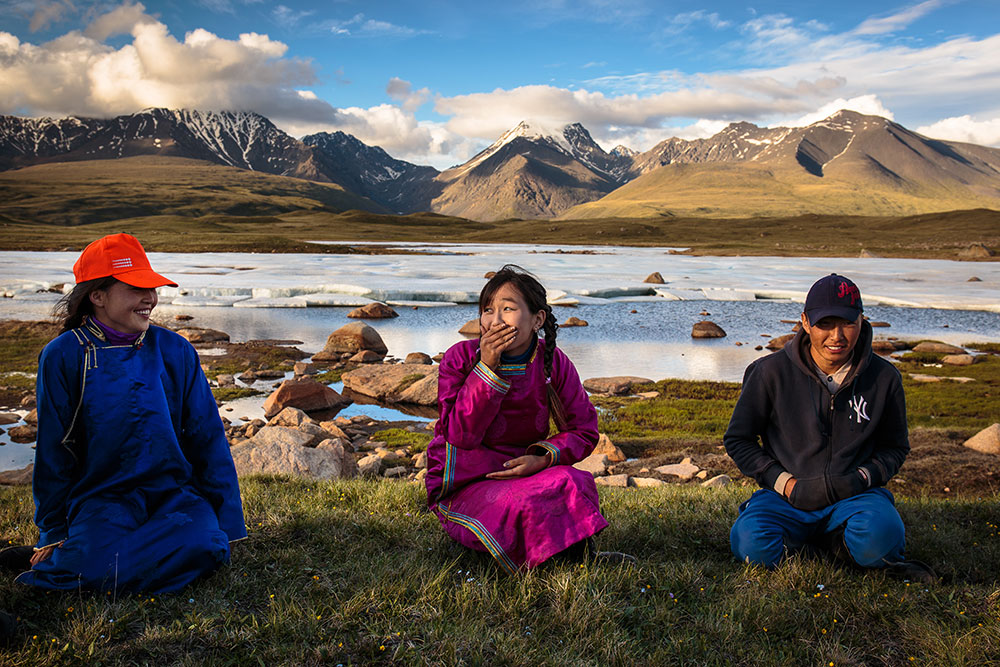
Three young nomads (L-R) Otga, Nana and
Choinum sit by the Shivreen River. Their generation faces a difficult
choice: continue their traditional life or move to the city.
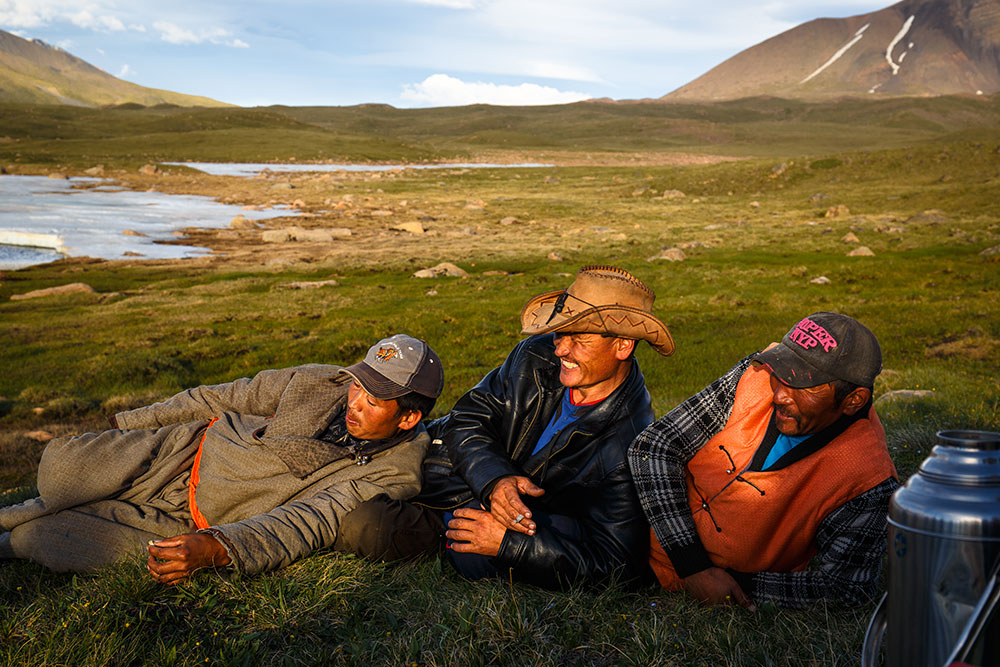
Chief herdsman Myagaa (C) and his friends live much the same lifestyle as their ancestors did 5,000 years ago.
“They move according to the needs of their animals,” says
Cope. “Horses, goats, camels and yaks are all naturally nomadic, so
instead of putting them into paddocks with fences and stables, they move
with them the way the animals would naturally move in the wild.”
Each day we trek for anywhere between six and 10 hours, up and down steep slopes, over sand dunes, through deep snow, alpine forests, wet marshlands and numbingly cold streams. The weather swings from one extreme to the other, and we frantically change from thermals into rain gear and back into summer clothes in an effort to keep up with it. At one point I give up, and find myself walking in sodden shorts, my legs pelted by a hailstorm just minutes after they’d been scorched by the sun.
The herders, on the other hand, wear a heavy coat called a deel whatever the weather. It prevents saddle sores and seems to be endlessly capacious, as anything you give a nomad, no matter how large, gets promptly tucked away into the tunic’s front fold. Only at night do they take off their deel, to sleep huddled together in the great outdoors, under a pile of felts they share with the camels when the temperature drops. And, when we wake with frost on our tents, shivering in our thermals and Arctic-grade sleeping bags, the herders greet us cheerfully.
The higher we ascend, the richer the pastures become. We cross over the high pass between the Turgen and Kharkhiraa peaks, reaching, at about 2,900 metres, a series of shimmering, partially frozen lakes.
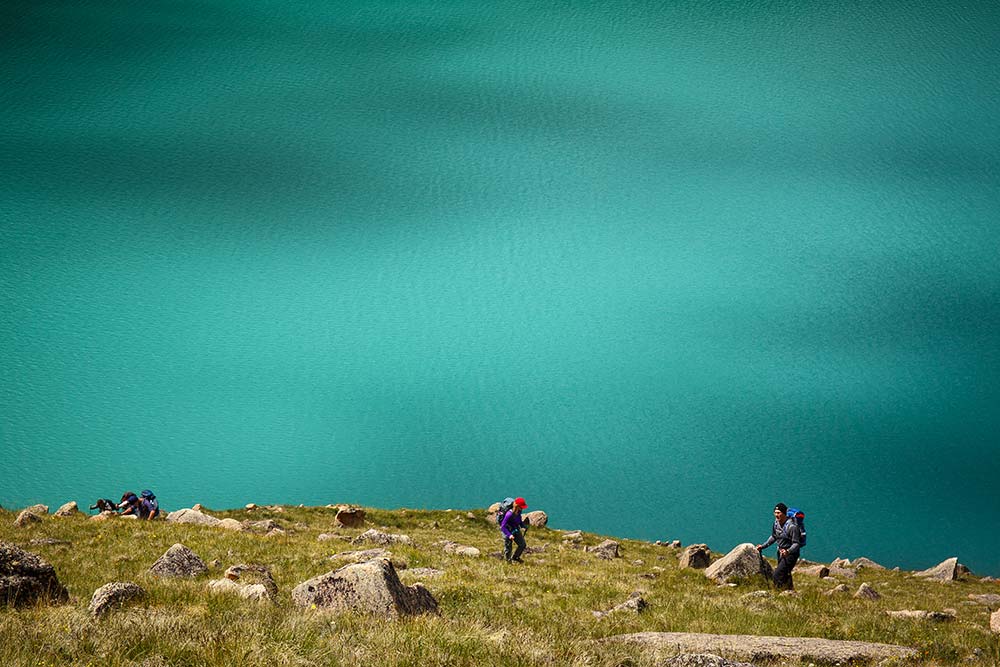
Trekkers visit a glacial lake on the high pass between the Turgen and Kharkhiraa ranges.
“It’s not that cold!” shouts Max, an intrepid 69-year-old
who’s celebrating his retirement, as he jumps into one of the lakes in
his underpants.
Some of us opt to continue the climb to the top of a vertiginous snowy ridge in the Turgen range. The air noticeably thins as we inch higher up a steep, gravelly slope, leaning on our trekking poles and panting like old women. From the top, at some 3,700 metres, the valley looks white and glacial. Few Mongolians venture this far, Cope says, let alone tourists. And, true enough, it feels like this massive land is ours alone. There’s nobody in sight, not even a single ger.
The descent proves even more challenging, as we slip and slide down a giant slab of ice, landing in rocky swamps below.
It’s a relief to make it to camp, in the shadow of the Kharkhiraa-Turgen mountains, where we’re introduced to Stephen. The lamb – it’s not clear who named him but it was unlikely to have been the herders – was purchased from a nearby family and is to be our lunch (Stephen Pasta), dinner (Stephen Soup) and breakfast (Stephen Surprise) for days to come.
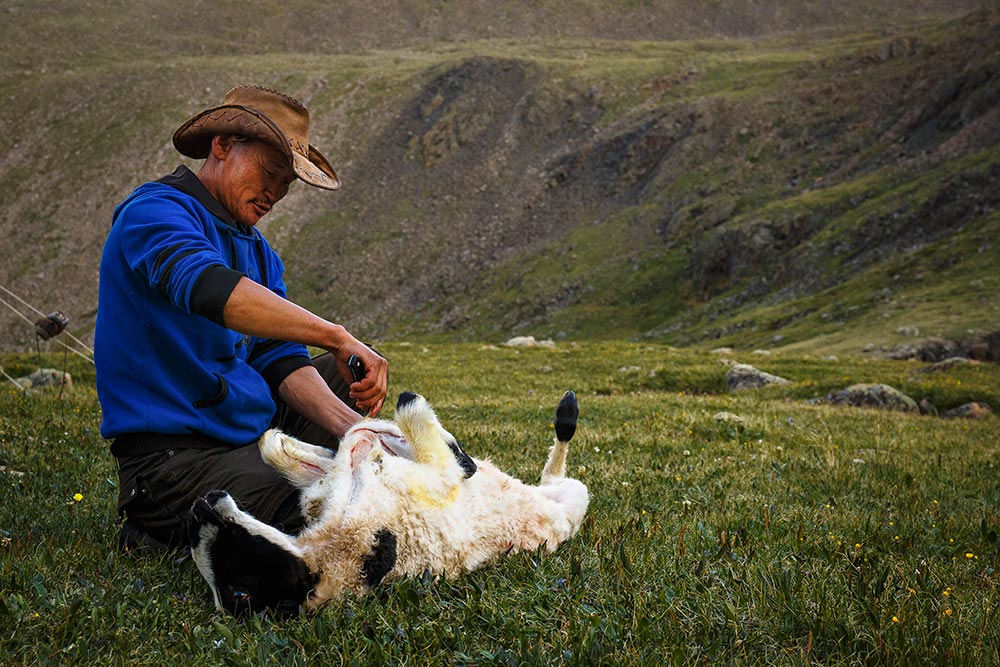
Myagaa skillfully performs a traditional lamb slaughter, where no blood is spilt.
Myagaa, 37, the lead herdsman, who has astonishingly white
teeth – which he flashes often – and the unmistakable swagger of a
cowboy, invites us to watch the slaughter. He cuts open the lamb’s
stomach, puts a hand inside and breaks the aorta, without spilling a
single drop of blood. Instead, he lets the upper cavity fill with the
blood, which will later be boiled in the intestine. Myagaa and fellow
herdsman Ankha skin and dry the hide; nothing goes to waste.
Trekking through the green summer pastures of Belchir – it's hard to keep track of exactly where we are – we come across a foal lying on the ground. It’s barely alive and there’s a large bite mark on one of its haunches. The victim of a wolf attack, its own herd must have fought, kicking to protect it from the pack.
Wolves represent a physical threat but are considered sacred by the nomads, who carry their dead to the mountains in the belief that when the predators devour a corpse, the spirit within will be transported to the afterlife. Wolves – like humans – also play an important role in keeping the numbers of grazing animals in check. Nevertheless, an increasing number of goats – prized because of the value of cashmere – has led to overgrazing in Mongolia.
A nomad’s wealth is measured by how many horses and livestock he has.
“We don’t need an income,” says the mother of a Khoton family – a tribe whose Turkic roots are apparent in their fair hair and eyes . “We live off our animals.”
That evening, while I jostle for washing space in a stream shared by yaks, camels and horses, I see the mother and her small children climb down the side of a steep gorge to fill up containers with water – about 30 litres, enough for the family for the following day.
“They live within the limitations and the confines of the environment that they were born into,” says Cope. “It’s an extremely different way of life to what most of us live, where we’ve basically moulded the land for our own convenience.”
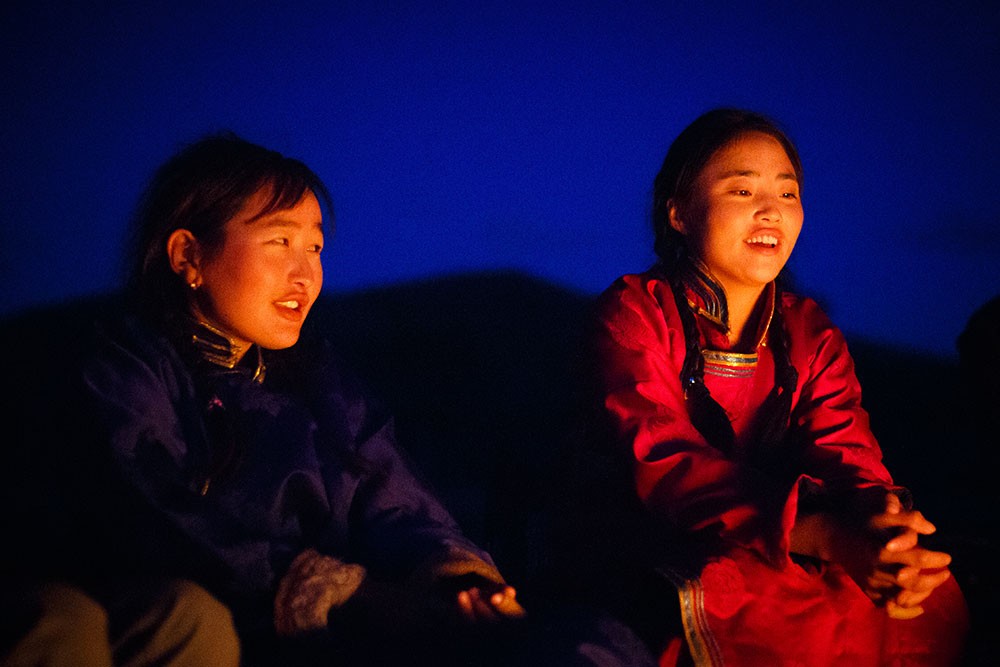
Young nomads Otga and Nana sing to the trekking group by the fire.
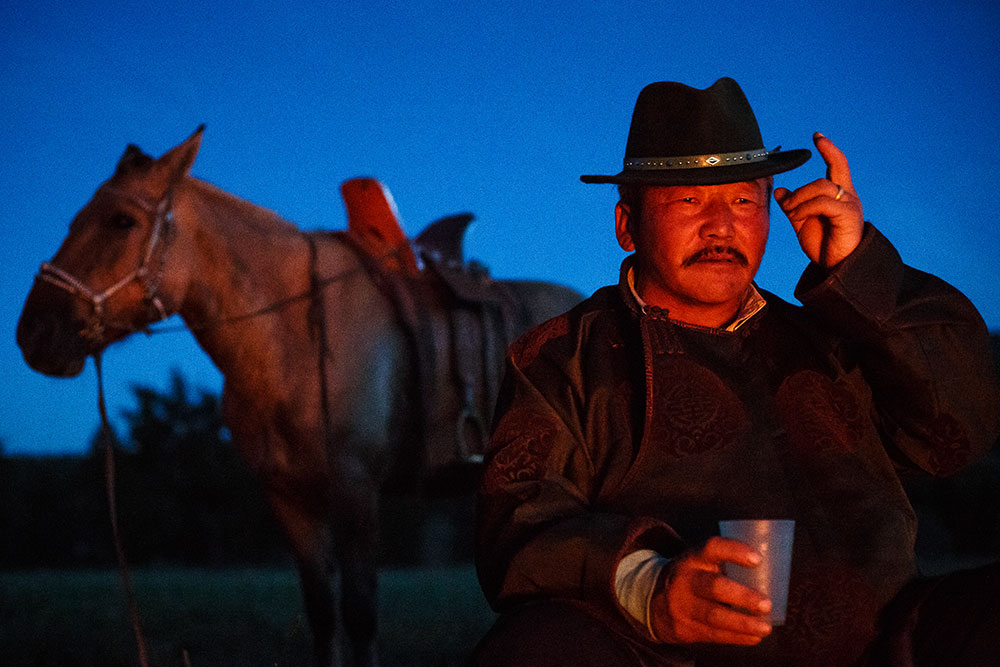
A travelling nomad stops by the camp's bonfire with his son for food and drink.
What does the future hold for these nomads? They don’t fit
into a market economy: they’re too self-sufficient and constantly on the
move. They don’t spend money so they don’t need salaries; they don’t
own fixed homes so the government can only tax them on their livestock.
Myagaa comes from a long line of nomadic herdsmen but isn’t sure what will become of his four children.
“I don’t know yet whether they will also become herders, it will depend on government policy,” he says. “If I send them to university, afterwards they may have no opportunity to work. How do I imagine our future? I don’t know at all.”
During one of our photo delivery rounds, we meet Davaa, who took Cope in one night 12 years ago, fed him marmot meat and offered him shelter. Will his grandchildren become nomads like him?
“Probably not,” says Davaa, passing around a mug of vodka while his wife plies us with freshly fried boortsog and heavy clotted cream. “They will follow their own path.”
The biggest change he’s seen in recent years, he says, is in the climate: “There’s not as much good grass any more. Life’s not as productive. Things are harder.”
Shown are temperature anomalies, or
how many degrees variation from the long term average, recorded each
July at a weather station near the Turgen Mountains. Source: UK Met
Office
The annual mean temperature in Mongolia has increased by
2.14 degrees Celsius since the 1940s, according to a United Nations
Environment Programme report, while precipitation is decreasing.
“When I was small, there was a lot of rain. Now, there’s not enough water,” says Myagaa. It is a situation that has been aggravated by the country’s sprawling, thirsty mining industry.
Given their dependence on the land, nomads are sensitive to even subtle changes in the climate. With the cold coming later in the year, for instance, they have to delay the freezing and preservation of the meat that will see them through the winter months.
Although rivers are drier in the summer, glaciers are melting, resulting in storms and flash floods.
Winters are generally becoming warmer but Mongolia is also experiencing more zuds: extreme winters that sweep across the steppe and wipe out millions of animals – some starve, others freeze to death.
“Nomadic life is like a bellwether for the rest of us,” says Cope. “It’s these very extreme fragile ecosystems that are the first to show the signs of climate change – they really are the canaries in the coal mine.”

Most children here will master horse riding from the age of four or five.
Stepping out of Davaa’s ger, I see from a distance what
look like miniature horsemen riding miniature horses and wonder if I’ve
perhaps had too much vodka. The riders turn out to be little boys, no
older than four or five years old, galloping bareback towards us.
Dismounting effortlessly, they walk with the same swagger as Myagaa,
eyeing us curiously. They exude freedom and independence.
“Mongolia is at a crossroads,” says Cope. “For the first time in thousands of years, the young generation of Mongolians have a choice, to be a herder or to pursue studies in the cities and towns and perhaps have a very different way of life.”
However, he remains optimistic that some will choose the steppe.
As the days progress, our notion of “home” changes. If before it meant mortgages and rooms full of belongings, for now, at least, it’s been reduced to the place we walk to each day, where we stop to eat and rest for the night.
Our group has begun to feel like a family – animals included. We’ve become used to camping out in the wild, to sleeping to the sound of animals munching outside our tents, even to the smell of camel sweat, which permeates our camping mats.
On our last night with the herdsmen, before we head back into a world of hot showers, Wi-fi and walls, they sing to us; songs of the land, their animals and their families, in rich baritone voices that fill the valley, leaving us speechless. And then mortified, when they ask us, smiling encouragingly, to return the favour.
Our only excuse is that they get a lot more practice than we do: they sing as they ride, they sing as they work.
Tessa Chan travelled as part of a small group trek in collaboration with World Expeditions.
Winners and losers in Mongolia's mining gold rush
Young nomads Otga and Nana keep warm by the bonfire.
A view to wake up to: horses graze by the frozen Shivreen River, Western Mongolia. Photos: Tessa Chan
A
young girl plays outside her ger on freshly sheared wool. It's sheep
shearing season, and this family will take their wool to sell in town.
The
number of goats being kept as livestock in Mongolia has been growing
due to the increased value of cashmere, leading to overgrazing.
A Khoton nomad rides home on his camel, in Khovd, Western Mongolia.
A lamb peeps out from a family ger in Khovd. The nomads living here have no salaries: it’s their livestock that sustains them.
Family
photos hang in a frame on the rear wall of a ger. All the gers follow
the same internal layout, with their photo shrine holding a key
position.
Young nomads Otga and Nana keep warm by the bonfire.
Mongolia’s nomads
Mongolia’s nomads: masters of their destiny in a changing world
What does the future hold for the next generation of nomads? Join us as we follow traditional herdsmen and their camels on a trek across the vast plains of remote Western Mongolia
Words and pictures: Tessa Chan
One piece of advice if you’re planning a trip to Mongolia: never ask a local, “When will we arrive?”Not only is it bad luck, it’s also considered extremely rude.
When our guide, Australian adventurer, filmmaker and author Tim Cope, tells us this, I presume it’s a romantic reference to nomadic life being all about “the journey”. A few car breakdowns later, I discover it’s to be taken literally: in this vast, unpredictable country, it’s pointless trying to predict how long it’ll take you to get anywhere.
Bird’s eye view: see Mongolia like you’ve never seen it before
<a target="_blank" href="http://vid.ly/7p9a3x"><img src="http://vid.ly/7p9a3x/poster" /></a>
We’re in Khovd – three hours by plane (flight times are a
little easier to estimate) from the capital, Ulan Bator – and have
driven to the end of the road. Cars no longer being an option, the nine
of us – a mixed group from around the world who’ve joined the World
Expeditions “Nomads and Naadam with Tim Cope” trek – will spend the next
couple of weeks following herdsmen and their animals through remote
Western Mongolia.While just under a third of Mongolians are nomadic or semi-nomadic, the four herders travelling with us are different in that they’re living much the same life as they would have thousands of years ago. They still travel by camel and use no generators or water pumps. They’re not tour guides, as such; they’ve been hired specifically to accompany us and apply their skills to our needs.
It takes time for eyes that are unfamiliar with the sprawling sandy plains and endless blue sky to adjust to the scale of the environment. There is no private land ownership, here, no farms, fields or fences. There’s no tourism infrastructure where we’re heading, either: no stores, no fridges, just what we (and our camels) can carry.
The herders laugh when I tell them they live like kings compared with us. But you do the maths: Mongolia’s 1.5 million square kilometres are shared by just 3 million people, making it the most sparsely populated country in the world. Hong Kong, at just 1,104 sq km, is home to 7.24 million.
We walk from breakfast through to dinner, the camel train following with our tents and duffel bags. One beast groans loudly each time its load is packed and unpacked, protesting like a grumpy old man, his mouth full of food. These creatures are surprisingly agile and strong, however, and when nomadic communities migrate from one pasture to another, a single animal will carry up to 300kg: all a family’s wordly belongings and their ger, their round tent-like homes commonly referred to by the Turkic word yurt.

By the time we reach our first camp – the herdsmen having raced ahead on the camels to set up the tents – our legs are buckling.
We’re invited into a ger that has been set up for the season nearby, and offered salted yaks’ milk tea, curd and boortsog (fried dough sticks). The tent’s residents are the first of many Khovd families we’ll pay informal visits to. At each ger, we’ll be given a traditional nomad welcome: copious amounts of food, tea and home-brewed vodka.
Twelve years ago, such hospitality provided Cope with a lifeline during a three-and-a-half-year horseback ride from Mongolia to Hungary, a journey he later recounted in a film series and book, titled On the Trail of Genghis Khan.

Source: 2015 World Bank data
SCMP
One night, sitting in front of the icy Shivreen River, we introduce ourselves properly to the herdsmen and our two beautiful young Mongolian cooks, Otga and Nana. They listen intently while we ramble on about our jobs, families and pets, Tsenkhee translating. I ask them what they like most about being a nomad.
“All,” says one. “The animals,” says another. What do they like least? “Nothing.”
Over the days that follow, we trace the migratory path of nomadic families as they move to their summer camps, seeking out higher pastures to escape the heat and mosquitoes.


Each day we trek for anywhere between six and 10 hours, up and down steep slopes, over sand dunes, through deep snow, alpine forests, wet marshlands and numbingly cold streams. The weather swings from one extreme to the other, and we frantically change from thermals into rain gear and back into summer clothes in an effort to keep up with it. At one point I give up, and find myself walking in sodden shorts, my legs pelted by a hailstorm just minutes after they’d been scorched by the sun.
The herders, on the other hand, wear a heavy coat called a deel whatever the weather. It prevents saddle sores and seems to be endlessly capacious, as anything you give a nomad, no matter how large, gets promptly tucked away into the tunic’s front fold. Only at night do they take off their deel, to sleep huddled together in the great outdoors, under a pile of felts they share with the camels when the temperature drops. And, when we wake with frost on our tents, shivering in our thermals and Arctic-grade sleeping bags, the herders greet us cheerfully.
The higher we ascend, the richer the pastures become. We cross over the high pass between the Turgen and Kharkhiraa peaks, reaching, at about 2,900 metres, a series of shimmering, partially frozen lakes.

Some of us opt to continue the climb to the top of a vertiginous snowy ridge in the Turgen range. The air noticeably thins as we inch higher up a steep, gravelly slope, leaning on our trekking poles and panting like old women. From the top, at some 3,700 metres, the valley looks white and glacial. Few Mongolians venture this far, Cope says, let alone tourists. And, true enough, it feels like this massive land is ours alone. There’s nobody in sight, not even a single ger.
The descent proves even more challenging, as we slip and slide down a giant slab of ice, landing in rocky swamps below.
It’s a relief to make it to camp, in the shadow of the Kharkhiraa-Turgen mountains, where we’re introduced to Stephen. The lamb – it’s not clear who named him but it was unlikely to have been the herders – was purchased from a nearby family and is to be our lunch (Stephen Pasta), dinner (Stephen Soup) and breakfast (Stephen Surprise) for days to come.

Trekking through the green summer pastures of Belchir – it's hard to keep track of exactly where we are – we come across a foal lying on the ground. It’s barely alive and there’s a large bite mark on one of its haunches. The victim of a wolf attack, its own herd must have fought, kicking to protect it from the pack.
Wolves represent a physical threat but are considered sacred by the nomads, who carry their dead to the mountains in the belief that when the predators devour a corpse, the spirit within will be transported to the afterlife. Wolves – like humans – also play an important role in keeping the numbers of grazing animals in check. Nevertheless, an increasing number of goats – prized because of the value of cashmere – has led to overgrazing in Mongolia.
A nomad’s wealth is measured by how many horses and livestock he has.
“We don’t need an income,” says the mother of a Khoton family – a tribe whose Turkic roots are apparent in their fair hair and eyes . “We live off our animals.”
That evening, while I jostle for washing space in a stream shared by yaks, camels and horses, I see the mother and her small children climb down the side of a steep gorge to fill up containers with water – about 30 litres, enough for the family for the following day.
“They live within the limitations and the confines of the environment that they were born into,” says Cope. “It’s an extremely different way of life to what most of us live, where we’ve basically moulded the land for our own convenience.”


Myagaa comes from a long line of nomadic herdsmen but isn’t sure what will become of his four children.
“I don’t know yet whether they will also become herders, it will depend on government policy,” he says. “If I send them to university, afterwards they may have no opportunity to work. How do I imagine our future? I don’t know at all.”
During one of our photo delivery rounds, we meet Davaa, who took Cope in one night 12 years ago, fed him marmot meat and offered him shelter. Will his grandchildren become nomads like him?
“Probably not,” says Davaa, passing around a mug of vodka while his wife plies us with freshly fried boortsog and heavy clotted cream. “They will follow their own path.”
The biggest change he’s seen in recent years, he says, is in the climate: “There’s not as much good grass any more. Life’s not as productive. Things are harder.”
Temperature graph from 1937 - 2014
“When I was small, there was a lot of rain. Now, there’s not enough water,” says Myagaa. It is a situation that has been aggravated by the country’s sprawling, thirsty mining industry.
Given their dependence on the land, nomads are sensitive to even subtle changes in the climate. With the cold coming later in the year, for instance, they have to delay the freezing and preservation of the meat that will see them through the winter months.
Although rivers are drier in the summer, glaciers are melting, resulting in storms and flash floods.
Winters are generally becoming warmer but Mongolia is also experiencing more zuds: extreme winters that sweep across the steppe and wipe out millions of animals – some starve, others freeze to death.
“Nomadic life is like a bellwether for the rest of us,” says Cope. “It’s these very extreme fragile ecosystems that are the first to show the signs of climate change – they really are the canaries in the coal mine.”

“Mongolia is at a crossroads,” says Cope. “For the first time in thousands of years, the young generation of Mongolians have a choice, to be a herder or to pursue studies in the cities and towns and perhaps have a very different way of life.”
However, he remains optimistic that some will choose the steppe.
"Over the years I’ve been coming here, I’ve seen that nomads really take pride in this life. And while there are some who may prefer to move to the city, there’s always someone in the family who wouldn’t give all this up for a million dollars."– Tim Cope“Over the years I’ve been coming here, I’ve seen that nomads really take pride in this life. And while there are some who may prefer to move to the city, there’s always someone in the family who wouldn’t give all this up for a million dollars.”
As the days progress, our notion of “home” changes. If before it meant mortgages and rooms full of belongings, for now, at least, it’s been reduced to the place we walk to each day, where we stop to eat and rest for the night.
Our group has begun to feel like a family – animals included. We’ve become used to camping out in the wild, to sleeping to the sound of animals munching outside our tents, even to the smell of camel sweat, which permeates our camping mats.
On our last night with the herdsmen, before we head back into a world of hot showers, Wi-fi and walls, they sing to us; songs of the land, their animals and their families, in rich baritone voices that fill the valley, leaving us speechless. And then mortified, when they ask us, smiling encouragingly, to return the favour.
Our only excuse is that they get a lot more practice than we do: they sing as they ride, they sing as they work.
Tessa Chan travelled as part of a small group trek in collaboration with World Expeditions.
See more reports on Mongolia in Post Magazine
Photo essay: Mongolia’s fearless child jockeys race for glory at NaadamWinners and losers in Mongolia's mining gold rush














